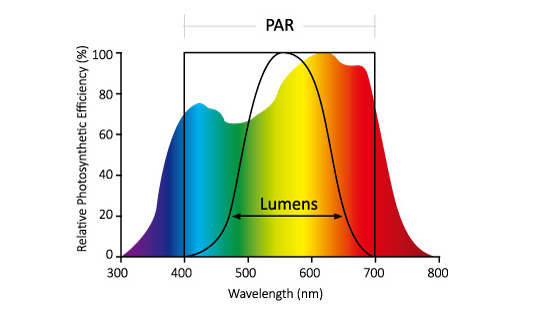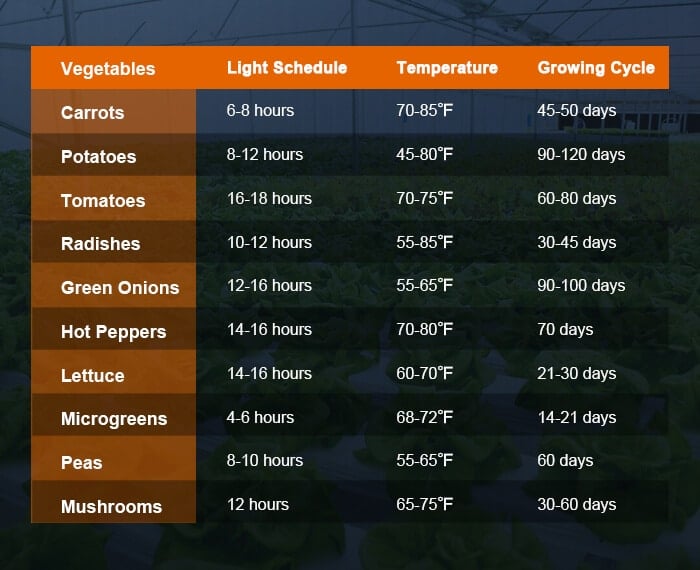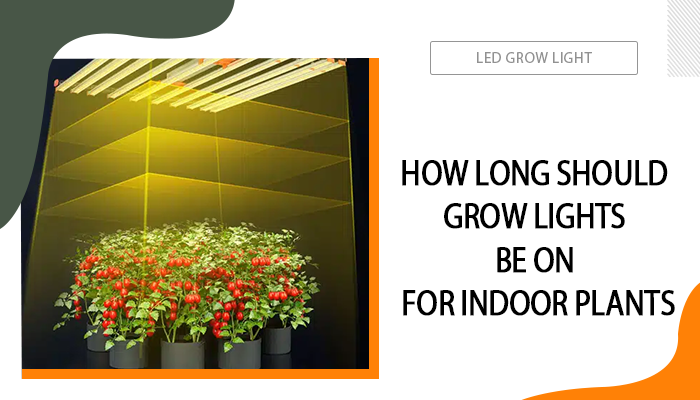How Long Should Grow Lights Be On Plants in All Stages
As an indoor grower, knowing the time of light needed to grow your plants is the first step to start growing. Light is the food source of plants - plants cannot photosynthesize without adequate light sources, which can lead to slow growth or even death. However, it may be confusing for beginners to figure out how long should grow lights be on, though qualifying companies such as Spider Farmer will offer manual guidelines along with the product.
Depending on multiple factors such as the growth stages of the plant, plant varieties, DLI, and PPFD, how long should grow lights be on can have different answers. To help you determine the right period of time, we’ve prepared the following article.
Table of Contents
Factors Determining How Long Should Grow Lights Be On
There’s no one-for-all light exposure solution. Only by understanding the factors that influence light exposure for your plants can you pursue optimal growth.
Plant Species and Varieties
Plants exhibit specific photoperiodic responses based on their species and varieties. Short-day plants, such as cactus and strawberries, require a period of uninterrupted darkness longer than a critical threshold to initiate flowering. On the other hand, long-day plants, such as lettuce and spinach, initiate flowering when they experience nights shorter than a specific duration.
Plant Growth Stage
As plants progress through different stages of plant growth, their light requirements change. During the initial stages of germination and early seedling development, plants require more light to support the energy-intensive process of photosynthesis and encourage healthy root and shoot growth. As they enter the vegetative stage, plants focus on leaf and stem development, requiring extended light exposure. When they transition to the flowering stage, they need less light as they prioritize flower and fruit production.
Duration of Light Exposure
DLI (Daily Light Integral) measures the total amount of light accumulated by plants in a 24-hour period. Different plants have varying DLI needs, with decorative indoor plants like pothos or snake plants requiring a DLI of 1-4 mol/m2/day, while edible plants typically need a DLI in the 10-30 mol/m2/day range. Similar to how we need a certain number of calories each day, providing plants with insufficient DLI over time can adversely affect their growth and health.
Light Intensity
PPFD measures the intensity of light that reaches a specific area at a given moment. It quantifies the number of photons hitting the plant's surface per unit of time. Once you have determined the total volume of light (DLI) your plants need daily and the ideal duration for delivering it, you can easily calculate the ideal light intensity by dividing the DLI by the duration.

Image source: horti-growlight.com
For example, if your plant requires a DLI of 20 mol/m²/day, and you plan to provide light for 10 hours each day, you would divide 20 by 10 to deduce that you need to deliver light at a rate of 2 mol/m²/hour.
In addition to these 4 crucial factors, others such as the grow light distance and types of grow lights can also affect how long should a grow light be on a plant.
How Long Should Grow Lights Be On For Indoor Plants
The first thing you need to know is that indoor and outdoor growing environments differ greatly, and indoor plants grown under artificial lights require more light hours than those grown outdoors.
Although there’s no perfect answer that fits all use cases, experienced growers do provide some insights on how long should a grow light be on. In general, plants under grow lights need at least 8-10 hours of light per day, but no more than 18 hours - make sure your plants have at least 6 hours of rest per day. And you can tell why LED grow lights become so popular, thanks to their high energy efficiency and relatively low electricity cost.
Read also: How Much Do LED Lights Cost?
To offer some light exposure instructions for common vegetables, including microgreens, peppers, and carrots, you can check the table below.

Conclusion
In conclusion, various factors can determine how long should grow lights be on. By tailoring the light schedule based on these factors and closely monitoring the plants' response, growers can provide optimal light conditions to support healthy and thriving vegetation. If you have no clue where to start, try lighting up your indoor plants for at least 8 hours a day, then monitor and upgrade or downgrade the light exposure.
FAQs about How Long Should Grow Lights Be On
- How long can you leave a grow light on a plant?
The duration you can leave a grow light on a plant varies based on factors. As a general guideline, you can leave the grow lights on for 8 to 16 hours per day during the vegetative stage. However, never leave your plants under the grow lights for more than 18 hours.
- How long should grow lights be on per day?
For most indoor plants, including decorative species, a light exposure of 12 to 16 hours during the vegetative stage is recommended. As plants enter the flowering stage, some may benefit from a shorter light duration, typically 8 to 12 hours per day.
- How long should grow lights be on for seedlings?
Seedlings require ample light for healthy growth. Providing 14 to 18 hours of light per day is generally beneficial during the early stages. As seedlings mature and develop leaves, the light duration can be gradually reduced.
- Is 12 hours of grow light too much?
No, 12 hours of grow light per day is not too much during the vegetative and flowering stages. For flowering plants, a 12-hour light exposure is often ideal during the flowering stage to stimulate flower production.
- When should I turn off my grow lights?
If providing 12 to 16 hours of light per day during the vegetative stage, you can set the lights to turn off after the desired hours have elapsed. For flowering plants, adjust the schedule to maintain 10 to 12 hours of light per day during the flowering stage.





Why are my orange lilies leafs turning yellow?
Hi Mary,
Plant leaves turning yellow can be caused by a lot of factors, such as overwatering, underwatering, too much sunlight, etc. You can check our newly published post for reference: https://www.spider-farmer.com/why-are-my-peace-lily-leaves-turning-yellow/
Can I use just a simple timer with the sf 2000 model, or do your lights require a specific timer?
Thank yoi
Hi Tanya,
Yes, you can go with a random timer.
Good knowledge and will definitely help some growers out.
Thanks , very informative